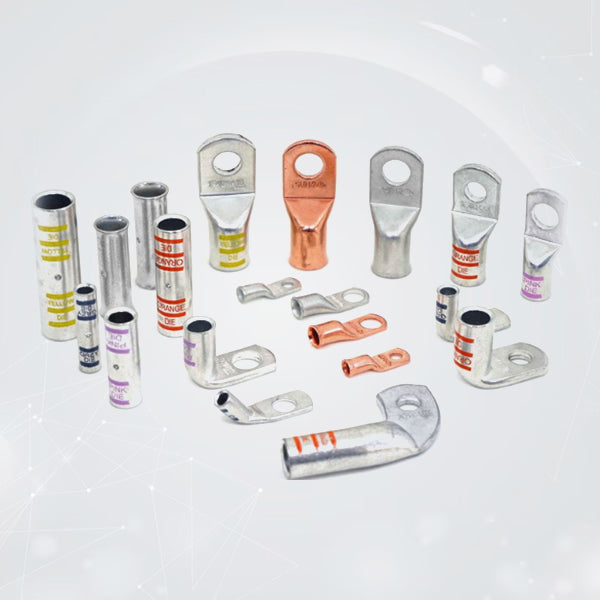
How to Choose Between Open-End and Ring-Type 6 AWG Lugs
When working with 6 AWG wire, one of the most important decisions you’ll make isn’t just about the cable itself—it’s about how you’re terminating it. Whether you're wiring a solar battery bank, connecting an inverter, upgrading a vehicle’s electrical system, or building out a marine setup, using the right lug matters.
But when it comes to 6 gauge lugs, you're faced with a common choice: open-end lugs or ring-type lugs. So how do you know which one is best for your application?
In this guide, we’ll break down the pros and cons of both lug types, when to use each, what to look for in a quality product, and why it’s crucial to choose the right 6 AWG copper lug for a reliable and safe electrical system.
What Are 6 AWG Lugs?
Before comparing types, let’s cover the basics. 6 AWG lugs are electrical connectors designed to securely terminate 6 gauge wire. These lugs typically connect to power sources such as batteries, bus bars, switches, or grounding points. Since 6 AWG wire is thicker and capable of handling around 55 to 65 amps (depending on insulation and environment), it requires durable lugs that ensure strong mechanical and electrical performance.
There are two common types of lugs for 6 AWG wire:
- Open-End Lugs (also called fork or spade terminals)
- Ring-Type Lugs (ring terminals)
Let’s explore both.
Open-End Lugs: Fast, Flexible, but Less Secure
What They Are
Open-end lugs, sometimes referred to as fork or spade lugs, feature a U-shaped opening at the terminal. This allows them to slide around a terminal stud without needing to completely remove the fastener.
Pros of Open-End 6 AWG Lugs
-
🔧 Quick Installation & Removal
Perfect for setups that require frequent changes or disassembly. You can slide them on or off the terminal without fully removing the bolt. -
🔄 Good for Temporary or Maintenance-Friendly Systems
If you’re setting up a temporary system or one that needs occasional tweaking, open-end lugs save time. -
🧰 Great for Tight Spaces
Easier to install where tool access is limited or where ring lugs might be too bulky.
Cons of Open-End Lugs
-
🚫 Not Vibration Resistant
In high-vibration environments (automotive, marine), open-end lugs can come loose over time if not securely fastened. -
⚠️ Potential for Disconnection
Since they aren’t fully enclosed, they carry a higher risk of slipping off the stud under certain conditions, especially if the terminal isn’t tightened properly.
Ring-Type Lugs: Maximum Security and Stability
What They Are
Ring-type lugs feature a fully enclosed circular terminal that fits around a stud or bolt. To install or remove, you must take off the fastener entirely.
Pros of Ring-Type 6 AWG Lugs
-
🔒 Most Secure Connection
Once installed, ring terminals cannot slip off without removing the fastener—ideal for permanent or critical installations. -
🚗 Excellent for High-Vibration Applications
Use these in vehicles, RVs, boats, and industrial machinery where consistent electrical contact is crucial. -
🌧️ More Reliable in Harsh Environments
Combined with heat shrink, ring lugs offer superior resistance to moisture, vibration, and oxidation.
Cons of Ring-Type Lugs
-
🕑 Slower to Install
You’ll need to fully remove and reattach the nut or bolt during installation and maintenance. -
🔩 Less Convenient for Temporary Setups
Not ideal for systems that are frequently disassembled or changed.
Choosing the Right Lug for Your Application
Here’s a quick guide to help you decide between open-end and ring-type 6 AWG battery lugs:
|
Use Case |
Recommended Lug Type |
|
Automotive/Mobile Power Systems |
Ring-Type |
|
Marine/RV/Boat Wiring |
Ring-Type |
|
Temporary or Test Equipment |
Open-End |
|
Low-Vibration, Indoor Applications |
Open-End |
|
Permanent Battery Connections |
Ring-Type |
|
Frequent Maintenance Access |
Open-End |
What to Look for in a Quality 6 AWG Lug
Regardless of the type, make sure your 6 AWG wire lugs meet the following standards:
✅ Correct Wire Gauge Fit
Always ensure the lug is specifically designed for 6 AWG wire. Using the wrong size can lead to a loose crimp or poor contact.
✅ High-Quality Copper Construction
Opt for 6 AWG copper lugs made of high-conductivity copper to reduce resistance and energy loss. Tinned versions are also available for corrosion resistance.
✅ UL or Industry Compliance
Look for UL-listed products or those that meet SAE or industry standards. This ensures quality, safety, and long-term performance.
✅ Compatible Stud Sizes
6 AWG lugs typically come in stud sizes like 1/4", 5/16", or 3/8". Make sure the stud hole matches your terminal for a snug and secure fit.
Top Choice: SELTERM 6 AWG Bare Copper Lugs
If you're looking for reliable, well-made lugs, the SELTERM collection of 6 AWG bare copper lugs is a trusted option used by pros in solar, automotive, industrial, and marine industries.
✅ Precision-forged from 100% pure copper
✅ UL-listed for performance and safety
✅ Offered in both ring-type and open-end options
✅ Multiple stud sizes available
✅ Easy to crimp and install with standard tools
🔗 Explore the full collection here
Installation Tips for 6 AWG Lugs
No matter which lug type you choose, proper installation is key:
-
Strip the Wire Correctly
Remove enough insulation so the wire fully seats in the lug barrel—but don’t over-strip. -
Use the Right Crimper
Invest in a high-leverage crimp tool designed for 6 gauge lugs. Don’t use pliers or basic crimpers. -
Crimp Firmly in Multiple Spots
Two or more crimp points are ideal for a solid electrical bond. -
Seal with Heat Shrink Tubing
Especially for outdoor or marine environments, heat shrink tubing helps seal out moisture and adds mechanical protection. -
Torque Studs Properly
Don’t under- or over-tighten. Refer to manufacturer specs for torque ratings on terminal studs.
Final Thoughts
Choosing the right lug for your 6 AWG wire can be the difference between a reliable, long-lasting connection and a system that fails under pressure. For high-vibration or permanent installs, ring-type 6 AWG battery lugs are the smart, secure option. For flexibility and ease of access, open-end 6 gauge lugs get the job done.
Whatever your project, make sure you're using trusted, well-made components like the 6 AWG copper lugs from SELTERM. With proper sizing, crimping, and sealing, your connections will be as strong and dependable as the cable itself.
Ready to Upgrade Your Connections?
👉 Shop SELTERM 6 AWG Bare Copper Lugs

